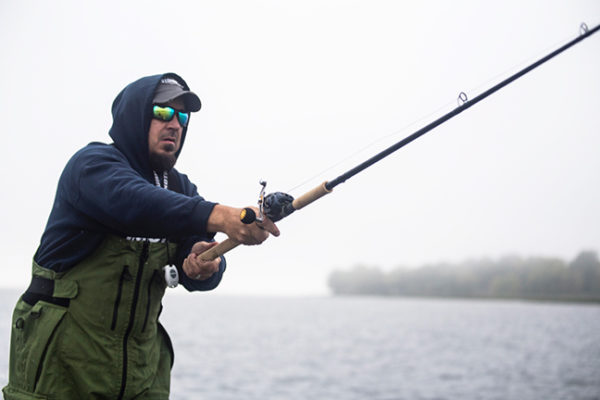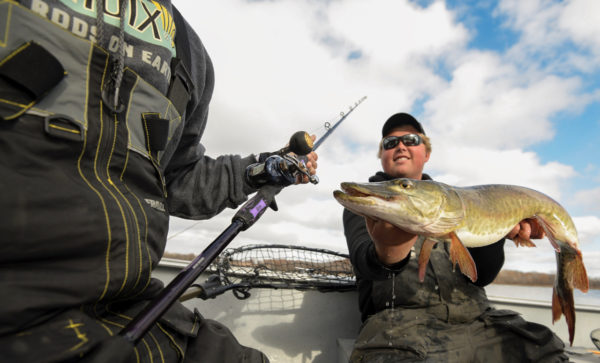ANGLING CURRENTS: Killer Late-Fall Musky Presentations and Considerations on Early Ice
Category: article
Oct 27th, 2021 by Keith Worrall
Modified Oct 27th, 2021 at 9:18 AM
ANGLING CURRENTS: Killer Late-Fall Musky Presentations and Considerations on Early Ice
By Josh Lantz
Fall is a magical time to be on the water, especially up north. The cottagers have mostly gone home and aside from the occasional pier-service vessel whisking away boat lifts or sections of dock, the clear, post-turnover waters are now largely the domain of anglers and waterfowl hunters.
In lakes and other waters where they exist, muskies are firmly on the feed, getting fat on whatever they can ambush – fish, muskrats, turtles, you name it. And amidst the drone of the distant leaf blowers, musky anglers are doing their best to capitalize, hoping to catch the biggest musky of their life before the waters freeze and they turn toward hard-water pursuits.
Late-Fall Musky Presentations
Like so many others employed at St. Croix Rod in Park Falls, Wisconsin, St. Croix Engineering Supervisor, Gavin Falk, is a passionate angler with a special penchant for Esox masquinongy. He says a one-two punch of casting and retrieving big rubber while offering live suckers near the boat is a dynamite combo for boating fat, fall muskies.
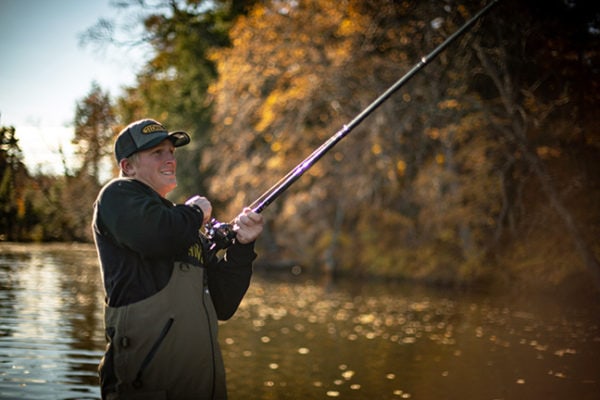
“I look at the offering – or sacrifice, more accurately – of live suckers as a value-added presentation most days in late fall,” says Falk. “It’s one I’ll usually combine with casting and retrieving big rubber baits, but it can easily turn into a go-to technique on certain days.” Falk says a live sucker is simply the most natural looking and smelling bait a musky angler can put in the water. “It’s also one of the easiest offerings for a fish to approach,” he adds. “Especially an interested fish that may have followed a lure to the boat but refused to eat it. The secondary presentation of suckers definitely helps to convert some of the more lethargic fish.”
Falk says feeding suckers to muskies is a hoot. “You never know how fish are going to react to your setups. Sometimes it’s a cat-and-mouse game with a series of calculated moves and other times it’s like watching a full-on horror movie,” he says. “I typically run a quick-strike set up under a big float out behind the boat with the bait suspended up higher in the water for boat-shy fish. Then I’ll usually also run one or two down rods – depending on the fishing regulations – at different depths. Those rods just go into the rod holders and fish straight down under the boat.”
Falk makes his own sucker rigs but says anglers can buy pre-made wire or fluorocarbon versions at just about any bait and tackle store in musky country. He fishes live suckers on a variety of St. Croix rods – including the company’s extremely popular Mojo Musky Series models – but says the 8’ heavy power, moderate action Premier Glass Musky Rod (PGM80HM) was made for this purpose. “Some days the higher sucker tends to get hammered and other days the fish want the deeper baits,” he adds. “It’s always surprising how some days the fish will come up five or even ten feet to hit a bait and other times you have to drop it right down to their face in order to get them to react, but all of this is what makes sucker fishing so much fun. Once they eat it, the Premier Glass rod has plenty of backbone to bury the hook and a moderate action that does a great job of minimizing stresses on the rod, line, terminal tackle, and the angler when a giant fish is going crazy so close to the boat.”
As mentioned, Falk often prefers to cast big rubber baits during late fall, often while soaking live suckers. “The primary benefit to throwing large rubber baits in fall is having the ability to fish down to the fish,” he says. “Once they move out of the weeds, muskies are often suspended near schools of bait in open water or relating to deep rock and wood along steep drop-offs. Large rubber baits can be counted down then fished slowly with a pull-pause technique to get deep muskies to strike.”
Falk’s favorite fall rubber baits are Pounder Bulldawgs, Lake X B52’s, Magnum Swimmin’ Dawgs, and 12” mid-depth Red October Tubes. “The Pounders I typically run deeper, especially when I’m marking fish around that 15’ depth on the graph. B52’s work best when the fish are running in 10’ or less. I’ll give them a couple seconds to hang between pulls; those baits suspend really well. I like Magnum Swimmin’ Dawgs when conditions are fairly flat because they present a very natural-looking presentation. And when I really start seeing suckers swimming around like crazy with muskies chasing them, tubes present the slightly more erratic presentation the fish want under those circumstances.”
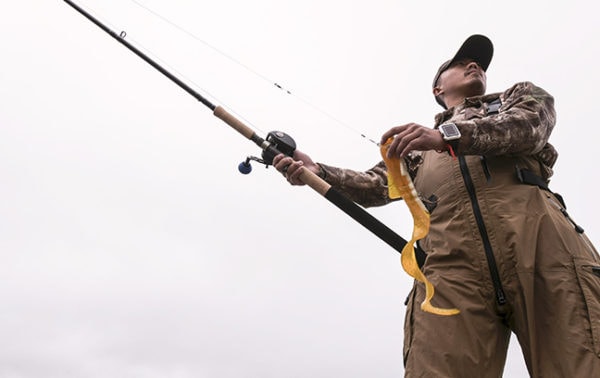
Falk runs all these baits on the St. Croix Premier Musky 9’ extra-heavy, fast action Rubber Rod (PM90XHF). “This rod was engineered to not only cast baits weighing up to a pound, but it also combines a heavy backbone to drive hooks home with the right amount of tip to produce an ideal action on these big, rubber lures,” Falk says. “I pair it up with an 8.1:1 Daiwa Prorex TW 400 reel with 80- or 120-pound Daiwa J-Braid. I run the Pandamonium Tackle Roswell wire leaders or those I make myself from 120-pound fluorocarbon. I really like the titanium leaders in cases when your bait tends to foul up; the hooks won’t nick or weaken the leader, and they don’t kink up like stainless leaders often do.”
Best-known, perhaps, for his work with Lindner Media, Jeremy Smith has worked in nearly every facet of the fishing industry. He agrees with Falk’s assessment on the efficacy of live suckers and big rubber in the late fall.
“I always have big rubber baits in the boat late in the year… mostly Pounder Bulldawgs and Magnum Medusas,” Smith says. “The key is getting them down to depth, and you need to slow them way down to do that.” Smith says the fish do respond to a faster retrieve, but there’s some tackle witchcraft that’s required. “Chaos Tackle makes Deep Threat Weights; I can put another ounce of weight on these baits so I can fish them faster while keeping them at the proper depth.” Smith says the Premier Musky Rubber Rod (PM90XHF) is the perfect tool for casting and retrieving these heavy baits. He pairs the rod with 100-pound braid on a Daiwa Prorex 8.1:1 reel. “Fast gearing pays off in order to get tight and hit the fish quickly. Also, these big rubber baits have an annoying tendency to foul, so don’t try to snap cast; be smooth and lob them so the bait doesn’t tumble, then slow them down with your thumb to turn them over before they land.”
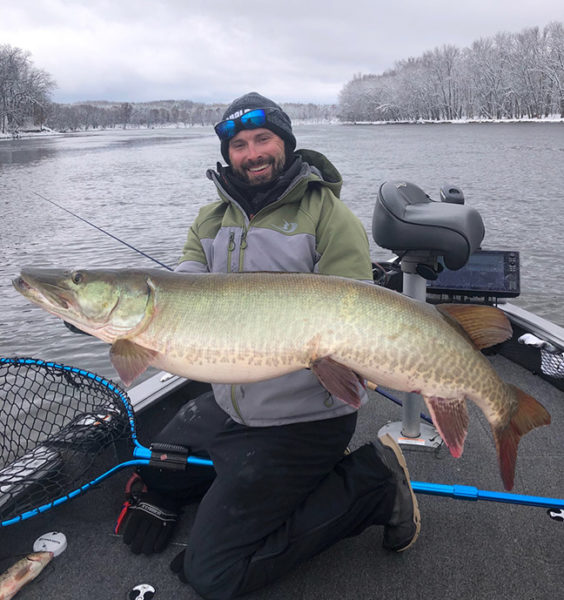
Smith offers readers insights into an additional presentation he’s found extremely effective on the Canadian Shield waters he often probes for giant, pre-ice muskies. “I use the St. Croix Premier Glass Musky Rod (PGM80HM) as a specialized trolling rod,” he says. “I learned several years ago on lakes like Lac Seul and Eagle – even with water temps in the high 30’s and low 40’s – how many big muskies are still shallow in that six-to-20 feet of water along the rocky shorelines,” Smith reveals. “It’s a great time for pulling big baits. I’m trolling big Supernatural Headlocks and Mattlocks, Storm Giant Flat Sticks, 14” Jakes and 13” Grandmas, but they create a ton of torque when you’re dragging them at three or four MPH and they are regularly banging into rocks. We sometimes pull these baits on five feet of line behind a planer board to get them right up next to shore, which adds even more resistance. It requires a really durable rod. The Premier Glass rod has the perfect amount of deflection without becoming overpowered,” Smith says. “That’s important because you can’t have a rod that’s already maxed out when a 50” musky smashes the bait. The moderate action of this rod holds fish really well, too. It’s just the ideal tool for this brutal style of fishing.”
Early Ice
The hard-water faithful never really stop thinking about ice fishing, but once the frost is on the pumpkins, they’re kicking preparations into high gear. Smith is one of those anglers.
“I’m still enjoying the special open-water opportunities that late fall provides, but that’s only going to last a few more weeks,” Smith says. “Very soon I’ll be venturing out on the ice, so I’m committing some time to assembling and attending to my gear.”
Smith points to safety as the primary consideration for all anglers during the early-ice period. “There are all kinds of resources and guidelines out there to help anglers make good decisions and ultimately prevent tragedies,” Smith says. “We’re all excited, but follow the simple mantra, ‘when in doubt, don’t go out’ and when you do, make sure you take every safety precaution. Don’t go alone, wear your ice picks and a PFD or a float suit. Early ice provides some great bites, but they aren’t worth risking your life over.”
Smith says early-ice anglers can expect good fishing in shallow weed bays. “These areas usually have safe ice first, and those shallow weeds can be full of panfish, bass, and other species.” Smith likes to fish such areas with Rippin’ Raps and Slab Raps. “Big crappies and largemouths love these presentations, and big gills will hit them, too,” he says. “If I’m exclusively fishing for bluegills, I’ll also use tungsten jigs tipped with spikes (maggots) or a wax worm.”
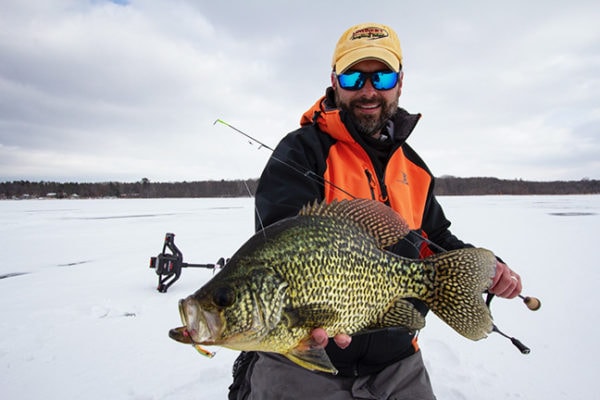
For rods, Smith relies on St. Croix’s top-performing ice-rod series, Croix Custom Ice (CCI). “I really love all the CCI rods,” he says, “but I find myself using the Perch Eye Spoon (CI28MLF) and Tungsten Tamer (CI28MLXF) models more than any others during the early-ice period, because they’re the best tools I’ve found for making the presentations I’m using most often. Weight is a big deal to me, and these CCI rods are incredibly light and sensitive. The Perch Seeker (CI32MLXF) and Spoon Hopper (CI36MLF) are two other models to consider if you’re fishing outside on clear ice and need to stay back a bit more from the hole. What St. Croix has done with the different composite and tubular blanks in this series is really remarkable,” Smith continues. “To offer ice anglers truly fast and even extra-fast actions in a tubular blank is a great example of St. Croix using its significant engineering and manufacturing capabilities for the benefit of anglers. These rods fish like nothing else I’ve ever used.”
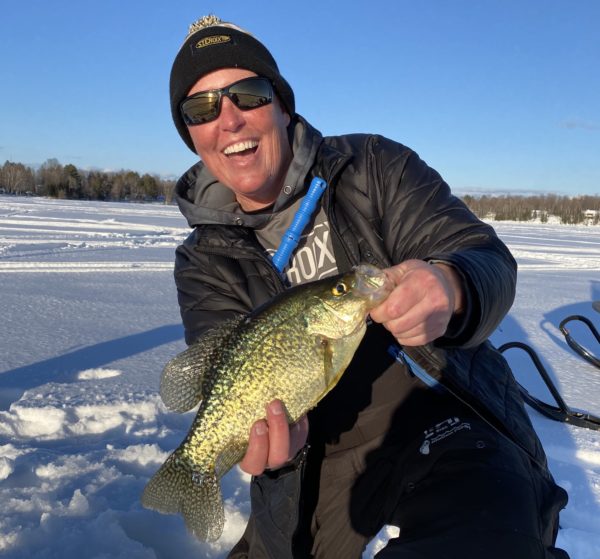
Wisconsin-based fishing instructor, charter captain and St. Croix pro, Barb Carey, is also gearing up for early ice. “I do a good amount of scouting at first ice, so I typically only carry a couple rods so I can travel light,” she says. “On many of my local lakes, the early-season fish I’m pursuing are really dependent on weed beds. That’s where the food and cover is, so a lot of times you’ve got to be right down in the thick stuff. When I’m searching for bites, I’m usually using micro-spoons, which present really well with St. Croix’s Mojo Ice MJI36L, so that rod really helps me cover water while searching for fish. The 36” length lets me stay on my feet and back a bit from the hole to avoid spooking fish in clear, early-ice conditions. The sensitivity of the Mojo Ice blank, fast tip, and unique reel seat and handle design all work together to make it easy to detect strikes. That’s important because it can be easy to get confused by what you are feeling in those thick weeds… a weed or some other environmental factor versus a fish sucking in the jig.”
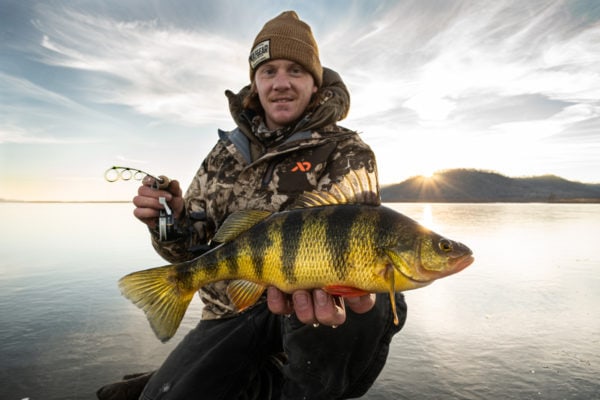
St. Croix pro, Hunter Rud, is also a fan of Mojo Ice rods, preferring the MJI24UL model. “First of all, I like the length of that rod for fishing inside a house,” the Minnesota pro says. “I sight fish a lot of really shallow water in the bays and backwaters of the Mississippi River, so the 24” length allows me to look down and see what’s happening without having my line pinch on the edge of the hole.” Rud defines “really shallow” as three, four, maybe five feet of water.
“As far as tactics go, my first priority during early ice is finding good, safe ice,” he says. “I spud my way out and pack pretty light. I pull a small, flip-over shelter for extra gear and to spread the weight out. I’m generally out fishing on the first two to four inches of ice – whatever I feel comfortable walking on – looking for that green vegetation that’s still producing oxygen. I catch fish in these spots every year.”
Rud says the water is generally pretty clean and visibility is usually really good from inside a shelter. “I like the shelter to keep things dark so I can sight fish the crappies, bluegills, and perch. The 24” Mojo Ice ultra-light is a great tool for this kind of sight fishing. I didn’t need a spring bobber or anything on it. It has a quick tip that translates bites well with a good backbone that delivers the power necessary for bigger panfish.”

“A 14- or 15-inch perch is no problem on this rod. The unique, lightweight reel seat and blank-thru handle are perfect for a pencil-grip-style hold and allow me to feel bites I may not see,” he says. “It’s light and crisp in the hand, and even though it’s an ultra-light, it still has plenty of power. I’m generally fishing really small tungstens or Lil’ Cecils, which present perfectly on this rod.”
Parting Words
Northern anglers have much to be excited about at this time of the year. For those still chasing giant muskies, some of the best days and weeks on the water are still to come, but they also relish the fact that they’ll have an entire hard-water season to enjoy once the lakes freeze up. So, heed their tips and make the most of the special opportunities the coming weeks provide. You just may be rewarded with the fish of a lifetime.
